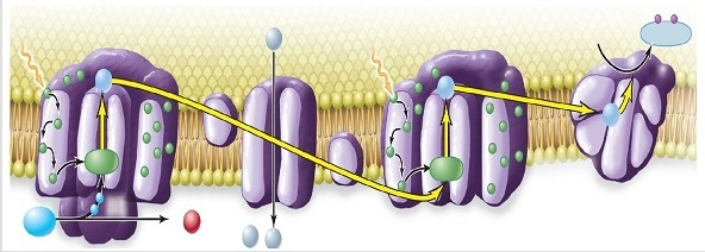A) CAM pathway plants are found in desert habitats.
B) All of these correctly match the pathway and the habitat.
C) C4 pathway plants are found in hot, open, grassy areas.
D) C3 pathway plants are found in most habitat areas.
F) A) and C)
Correct Answer

verified
Correct Answer
verified
True/False
For most lawn grasses to grow well in hot,dry weather,they must be watered so that their stomata will remain open for longer periods of time to let in O2.
B) False
Correct Answer

verified
Correct Answer
verified
True/False
When chlorophyll a absorbs light,electrons are "excited" and ejected from the chlorophyll a molecule.
B) False
Correct Answer

verified
True
Correct Answer
verified
Multiple Choice
The main organic product of photosynthesis is
A) sunlight.
B) oxygen.
C) glucose.
D) carbon dioxide.
E) chlorophyll.
G) C) and D)
Correct Answer

verified
Correct Answer
verified
Multiple Choice
Examples of accessory pigments for photosynthesis are
A) chlorophyll a and chlorophyll b.
B) mitochondria.
C) carotenoids, chlorophyll b, and chlorophyll a..
D) chlorophyll a and carotenoids.
E) chlorophyll b and carotenoids
G) All of the above
Correct Answer

verified
Correct Answer
verified
Multiple Choice
Combustion is an inorganic chemical reaction,with the net result of burning a log being a reverse reaction from photosynthesis.What products would be formed in burning a log?
A) carbon dioxide and glucose
B) oxygen and carbon dioxide
C) oxygen and water
D) carbon dioxide and water
E) glucose and oxygen
G) C) and E)
Correct Answer

verified
Correct Answer
verified
Multiple Choice
The sea slug Elysia chlorotica is a(n)
A) heterotrophic plant.
B) heterotrophic animal.
C) heterotrophic protist.
D) autotrophic plant.
E) autotrophic protist.
G) B) and E)
Correct Answer

verified
Correct Answer
verified
Multiple Choice
In plant cells,a membrane studded with photosynthetic pigments in plant cells is the
A) thylakoid.
B) stroma.
C) chlorophyll.
D) chloroplast.
E) granum.
G) D) and E)
Correct Answer

verified
A
Correct Answer
verified
Multiple Choice
In photosynthesis,the carbon in CO2 is being _____ to form glucose.
A) reduced
B) broken down
C) oxidized
D) respired
E) energized
G) A) and C)
Correct Answer

verified
Correct Answer
verified
Multiple Choice
What is a product of the electron transport chain started by photosystem II?
A) glucose
B) ADP
C) oxygen
D) water
E) NADPH
G) A) and C)
Correct Answer

verified
Correct Answer
verified
Multiple Choice
If a thylakoid is placed in a basic solution ATP synthesis will occur.How is this possible?
A) An electron gradient is created by the difference in pH.
B) A proton gradient is created by the difference in pH.
C) ATP is formed spontaneously at low pH.
D) ATP cannot be broken down at low pH.
E) The carbon reactions are blocked in the thylakoid at high pH.
G) B) and C)
Correct Answer

verified
Correct Answer
verified
Multiple Choice
Plants require a lot of water for hydration,metabolism,homeostasis,and photosynthesis.How is water used in photosynthesis?
A) to combine with NADP+ to form NADPH
B) as an electron donor in the photosystems
C) as a substrate for ATP synthase
D) as an electron acceptor in the electron transport chain
E) to combine with ADP forming ATP
G) B) and E)
Correct Answer

verified
Correct Answer
verified
Multiple Choice
How do C4 plants minimize photorespiration?
A) The light reactions and carbon reactions occur in different cells, so carbon dioxide does not come into contact with rubisco.
B) Stomata are only opened at night, storing oxygen in malate. During the day the oxygen is released for photosynthesis.
C) Stomata are only opened at night, storing carbon dioxide in malate. During the day the carbon dioxide is released for photosynthesis.
D) The light reactions and carbon reactions occur in different cells, so oxygen does not come into contact with rubisco.
F) All of the above
Correct Answer

verified
Correct Answer
verified
True/False
C4 plants and CAM plants fix carbon twice during the photosynthetic reactions.
B) False
Correct Answer

verified
Correct Answer
verified
Multiple Choice
Which of these groups represents organisms that are heterotrophs?
A) microorganisms that harness solar energy, converting it to chemical energy
B) non-photosynthesizing bacteria, fungi, earthworms
C) all organisms that developed after photosynthesis
D) photosynthesizing bacteria, algae, ferns, pine trees
F) B) and C)
Correct Answer

verified
Correct Answer
verified
Multiple Choice
Which plants keep their stomata open only at night?
A) C4
B) C3
C) CAM
E) B) and C)
Correct Answer

verified
Correct Answer
verified
Multiple Choice
Figuer:
Examine this image, showing an electron transport chain in photosynthesis.  -What is released at each step in an electron transport chain?
-What is released at each step in an electron transport chain?
A) ultraviolet wavelengths
B) electrons
C) energy
D) photons
F) C) and D)
Correct Answer

verified
C
Correct Answer
verified
Multiple Choice
Which of these organisms can carry out photosynthesis?
A) algae
B) cyanobacteria
C) plants, algae, and cyanobacteria
D) plants
E) a coral
G) A) and C)
Correct Answer

verified
Correct Answer
verified
Multiple Choice
Which organism depends on photosynthesis for its life?
A) All of the answer choices are correct.
B) a human
C) an oak tree
D) a coral
E) a sea slug
G) D) and E)
Correct Answer

verified
Correct Answer
verified
Multiple Choice
Photosynthesis is
A) not an oxidation-reduction reaction.
B) an energy transfer process that produces glucose and oxygen.
C) a chemical process not dependent on chlorophyll.
D) None of the answer choices are correct.
E) a set of reactions that produces water and carbon dioxide.
G) A) and B)
Correct Answer

verified
Correct Answer
verified
Showing 1 - 20 of 74
Related Exams